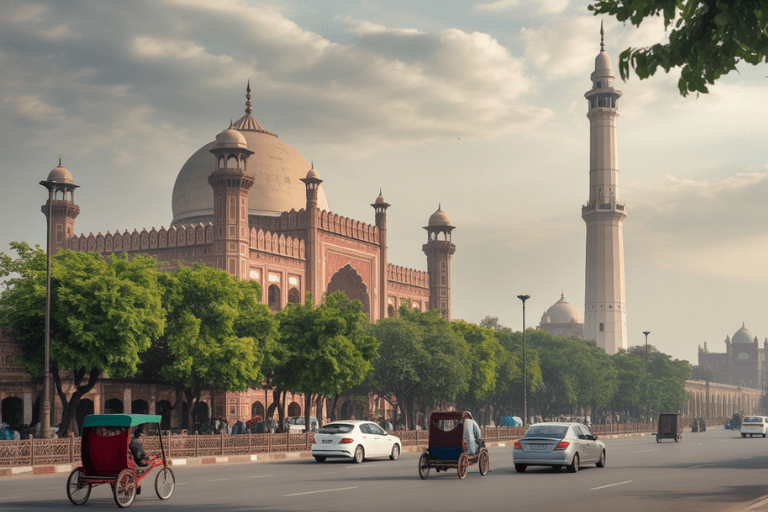Lahore, the heart of Pakistan, is a city known for its culture, food, architecture — and of course, its distinct weather patterns. Whether you’re a resident, traveler, or someone planning to visit the “City of Gardens,” understanding Lahore weather can help you plan your activities, clothing, and travel perfectly.
This article covers everything from Lahore’s seasonal climate and temperature trends to air quality, forecast updates, and tips to stay comfortable year-round.
Overview of Lahore’s Climate
Lahore experiences a semi-arid climate, meaning it has hot summers, short monsoons, and cool winters. The city’s weather is influenced by both continental and monsoon systems, bringing diversity across the months.
- Average Annual Temperature: Around 24°C (75°F)
- Hottest Month: June (up to 45°C / 113°F)
- Coldest Month: January (down to 5°C / 41°F)
- Rainiest Month: July and August
This variation makes Lahore weather one of the most dynamic in Pakistan — sometimes sunny and vibrant, other times rainy and misty.
Summer in Lahore (April to September)
Lahore summers are long, dry, and hot. From April to June, the temperature can soar above 40°C, with May and June being the most intense months.
The arrival of monsoon rains in July and August brings some relief, lowering the temperature but increasing humidity.
Key Features:
- Daytime temperatures: 38°C to 45°C
- Nights remain warm around 25°C to 30°C
- Frequent dust storms before rain
- Ideal for: Indoor activities, evening hangouts, and enjoying mangoes!
Tip: Stay hydrated and avoid direct sunlight during peak hours (12 PM – 4 PM).
Monsoon Season (July to September)
Monsoon in Lahore transforms the city. The rain brings greenery, freshness, and a welcome escape from the scorching heat.
However, urban flooding, traffic slowdowns, and humidity can make life challenging.
Average Rainfall: 500 mm annually (mostly during monsoon months)
Common Issues: Waterlogging, power cuts, and slippery roads
Despite the inconvenience, the Lahore monsoon remains beautiful, making the Canal Road, Shalimar Gardens, and Model Town Park lush and vibrant.
Autumn in Lahore (October to November)
Autumn brings balance. The temperature drops to a pleasant 20–28°C, with mild sunshine and clear skies.
This is one of the best times to visit Lahore, as the city becomes more photogenic, and outdoor activities like cricket, walks, and street food tours are in full swing.
Fun Fact: Lahore’s autumn sunsets near Badshahi Mosque and Minar-e-Pakistan are some of the most picturesque in South Asia.
Winter in Lahore (December to February)
Lahore winters are cool, foggy, and calm. The temperature can dip to 4–5°C in January, especially at night.
Fog often covers highways and roads, causing visibility issues but adding a mystical beauty to the city’s mornings.
Typical Winter Weather:
- Temperature: 8°C to 20°C
- Low humidity
- Frequent fog and smog in December and January
Winter Vibes:
Locals enjoy hot tea, fish fry, halwa puri, and bonfires. It’s also the season for weddings and cultural festivals like the Faiz Festival and Lahore Eat.
Smog and Air Quality in Lahore
In recent years, air pollution and smog have become a serious concern during winter months (October to January).
Due to crop burning, industrial emissions, and traffic, the Air Quality Index (AQI) in Lahore often exceeds safe limits.
Average AQI: 200–300 (Unhealthy range)
Authorities have been implementing anti-smog measures, such as:
- Limiting factory emissions
- Restricting vehicle movement on high smog days
- Promoting tree plantation campaigns
Tip: Use N95 masks, air purifiers, and avoid outdoor exercise during smog alerts.
Lahore Weather Forecast and Updates
To stay updated on Lahore’s weather, residents often rely on:
- Pakistan Meteorological Department (PMD)
- BBC Weather
- AccuWeather and The Weather Channel
- Google Weather Forecasts
You can check daily temperature, rain alerts, humidity, and UV index to plan your day effectively.
Monthly Temperature Overview of Lahore
| Month | Avg. High (°C) | Avg. Low (°C) | Rainfall (mm) |
| January | 19 | 6 | 20 |
| February | 23 | 9 | 25 |
| March | 29 | 14 | 30 |
| April | 36 | 20 | 20 |
| May | 41 | 25 | 15 |
| June | 43 | 28 | 30 |
| July | 37 | 27 | 110 |
| August | 35 | 26 | 120 |
| September | 34 | 24 | 50 |
| October | 32 | 19 | 10 |
| November | 27 | 13 | 5 |
| December | 21 | 8 | 10 |
Best Time to Visit Lahore
The ideal months to visit Lahore are October to March.
During this time, the weather is cool, dry, and perfect for exploring landmarks like:
- Badshahi Mosque
- Lahore Fort
- Walled City Food Streets
- Shalimar Gardens
Travelers also get to enjoy festivals, local markets, and traditional foods without the discomfort of summer heat.
Climate Change and Lahore Weather
Like many South Asian cities, Lahore is feeling the effects of climate change — rising temperatures, unpredictable rains, and stronger storms.
Experts recommend urban greenery, renewable energy, and public awareness to help manage these changes.
Sustainable steps being discussed include:
- Solar-powered homes
- Tree plantation drives
- Recycling programs
- Awareness campaigns in schools
Conclusion — The Ever-Changing Beauty of Lahore Weather
From sun-drenched summers to foggy winters, Lahore weather reflects the city’s rich personality — vibrant, unpredictable, and full of life.
Whether you’re visiting for business, study, or tourism, knowing the Lahore weather forecast ensures your plans go smoothly.
Lahore’s charm isn’t just in its heritage — it’s also in how the weather shapes its mood, culture, and lifestyle every season.

